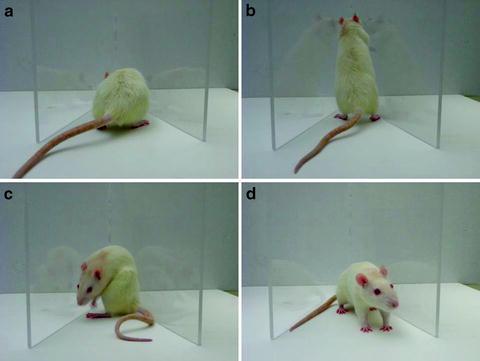Fig. 1.
The corner turn apparatus consists of two walls forming a 30° corner and a 5-mm gap at the apex of triangular tip.
3 Methods
3.1 Performing the Test (Fig. 2)

Fig. 2.
(a) Place the open-edge of apparatus near the edge of the table and permit the rodent to advance into the corner. (b) Full rearing and vertical exploration of the corner. (c) Turning to the side by placing one or both forepaws along the wall as the rodent shifts the weight around. (d) Completion of a full turn signifies a body position 180° from starting point.
1.
Allow the rodent to advance into the corner.
2.
The animal should turn either left or right by placing one or both forepaws on the wall as it shifts it weight around.
3.
Allow 30 s between trials to not develop an aversion to the corner.
3.2 Tabulating the Behavior
Repeat the test 10–15 times and record the number of right or left turns.
3.3 Calculating the CT Score
1.
CT score = [(R)/(R + L)] × 100
2.
Right turns (R); Left turns (L)
3.4 Presenting the Result
1.
Y-axis: CT score
2.
X-axis: animal group (e.g., sham, vehicle, treatment, etc.) or time-point
4 Notes
4.1 When to Perform the Test
4.2 Controlled Environment
1.
A quiet location with dim lighting is ideal (minimize the amount of light and sound during testing).
2.
The best time of day is during the first few hours of the dark part of light–dark cycles.
4.3 Technical Points
1.
Place the open-edge of the apparatus near the edge of the table to prevent escape during the trial.
2.
Hold the animal by the tail at the center of the distal end of the apparatus until the animal attempts to pull away from the grasp. This allows the animal to briskly proceed into the corner.
3.




Sit or stand directly behind the open ends of the corner apparatus, so as to not bias turning.
< div class='tao-gold-member'>
Only gold members can continue reading. Log In or Register to continue
Stay updated, free articles. Join our Telegram channel

Full access? Get Clinical Tree


